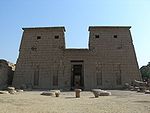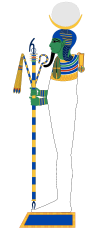- Khonsu
-
For other uses, see Khonsu (disambiguation).
Khonsu 
Khonsu as a falconGod of youth and the moon Name in hieroglyphs 





Major cult center Thebes Symbol the moon disk, the sidelock Parents Amun and Mut Siblings Monthu Khonsu (alternately Chonsu, Khensu, Khons, Chons or Khonshu) is an Ancient Egyptian god whose main role was associated with the moon. His name means "traveller" and this may relate to the nightly travel of the moon across the sky. Along with Thoth he marked the passage of time. Khonsu was instrumental in the creation of new life in all living creatures. At Thebes he formed part of a family triad with Mut as his mother and Amun his father. At Kom Ombo he was worshipped as son of Sobek and Hathor.[1]
Contents
Attributes
Khonsu is typically depicted as a mummy with the symbol of childhood, a sidelock of hair, as well as the menat necklace with crook and flail. He has close links to other divine children such as Horus and Shu. He is sometimes shown wearing a falcon's head like Horus, with whom he is associated as a protector and healer, adorned with the sun disk and crescent moon.[1]
He is mentioned in the Pyramid Texts and Coffin Texts, in which he is depicted in a fierce aspect, but he does not rise to prominence until the New Kingdom, when he is described as the "Greatest God of the Great Gods". Most of the construction of the temple complex at Karnak was centered on Khonsu during the Ramesside Period.[1] His temple at Karnak is in a relatively good state of preservation, and on one of the walls is depicted a cosmogeny in which Khonsu is described as the great snake who fertilizes the Cosmic Egg in the creation of the world.[2]
Khonsu's reputation as a healer spread outside Egypt; a stele records how a princess of Bekhten was instantly cured of an illness upon the arrival of an image of Khonsu.[3] King Ptolemy IV, after he was cured of an illness, called himself "Beloved of Khonsu Who Protects His Majesty and Drives Away Evil Spirits".
Locations of Khonsu's cult were Memphis, Hibis and Edfu.[1]
Etymology
His name reflects the fact that the Moon (referred to as Aah in Egyptian) travels across the night sky, for it means traveller, and also had the titles Embracer, Pathfinder, and Defender, as he was thought to watch over night travelers. As the god of light in the night, Khonsu was invoked to protect against wild animals, increase male virility, and to aid with healing. It was said that when Khonsu caused the crescent moon to shine, women conceived, cattle became fertile, and all nostrils and every throat was filled with fresh air.
Khonsu can also be understood to mean king's placenta, and consequently in early times, he was considered to slay the king's (i.e. the pharaoh's) enemies, and extract their innards for the king's use, metaphorically creating something resembling a placenta for the king. This bloodthirsty aspect leads him to be referred to, in such as the Pyramid texts, as the (one who) lives on hearts. He also became associated with more literal placentas, becoming seen as a deification of the royal placenta, and so a god involved with childbirth.
History








![D21 [r] r](/w/extensions/wikihiero/img/hiero_D21.png)




![X1 [t] t](/w/extensions/wikihiero/img/hiero_X1.png)

Khonsu of Thebes
The "Maker" of men's destinies –
Chonsu-pa-âri-sekher-em-"Uas-t"
in hieroglyphsPylon of the Temple of Khonsu at Karnak
Khonsu gradually replaced the war-god Monthu as the son of Mut in Theban thought during the Middle Kingdom, because the pool at the temple of Mut was in the shape of a crescent moon. The father who had adopted Khonsu was thought to be Amun, who had already been changed into a more significant god by the rise of Thebes, and had his wife changed to Mut. As these two were both considered extremely benign deities, Menthu gradually lost his more aggressive aspects.
In art, Khonsu was depicted as a man with the head of a hawk, wearing the crescent of the new moon subtending the disc of the full moon. His head was shaven except for the side-lock worn by Egyptian children, signifying his role as Khonsu the Child. Occasionally he was depicted as a youth holding the flail of the pharaoh, wearing a menat necklace. He was sometimes pictured on the back of a goose, ram, or two crocodiles. His sacred animal was the baboon, considered a lunar animal by the ancient Egyptians.
Modern culture
In modern pop culture, Khonsu plays a central role in the stories of the Marvel comic book character Moon Knight, and though only appears once in The Throne of Fire he plays a major role by giving Carter and Sadie extra time through the Duat at the expense of the god taking Bes's body and ren.
Notes
- ^ a b c d "The Oxford Guide: Essential Guide to Egyptian Mythology", Edited by Donald B. Redford, p186-187, Berkley, 2003, ISBN 0-425-19096-X
- ^ "Handbook of Egyptian Mythology", Geraldine Pinch, p156, ABC-CLIO, 2002, ISBN 1576072428
- ^ This incident is mentioned in the opening of chapter one of Bolesław Prus' 1895 historical novel Pharaoh.
Ancient Egyptian religion Mythology 


Deities Amun · Amunet · Anubis · Anuket · Apep · Apis · Aten · Atum · Bastet · Bat · Bes
Four sons of Horus · Geb · Hapi · Hathor · Heka · Heqet · Horus · Isis · Khepri
Khnum · Khonsu · Kuk · Maahes · Ma'at · Mafdet · Menhit · Meretseger · Meskhenet
Monthu · Min · Mnewer · Mut · Neith · Nekhbet · Nefertem · Nephthys · Nu · Nut · Osiris
Pakhet · Ptah · Qebui · Ra · Reshep · Satet · Sekhmet · Seker · Serket · Sobek
Sopdet · Sopdu · Set · Seshat · Shu · Taweret · Tefnut · Tatenen · Thoth · Wadjet
Wadj-wer · Wepwawet · WosretWritings Beliefs  Ancient Egypt PortalCategories:
Ancient Egypt PortalCategories:- Egyptian gods
- Lunar gods
- Time and fate gods
Wikimedia Foundation. 2010.

